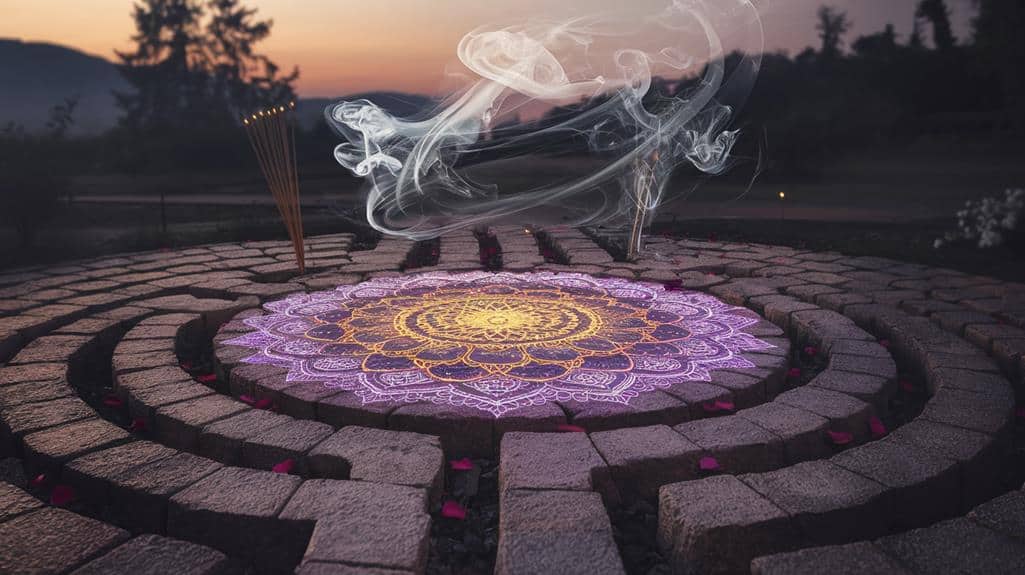The Use of Labyrinths and Mandalas in Mystical Practices
When you encounter a labyrinth or mandala, you’re stepping into a tradition that spans millennia and crosses cultural boundaries worldwide. These sacred patterns have guided seekers through spiritual journeys and meditative states, offering profound insights that extend far beyond their visual appeal. You’ll find these mystical tools embedded in the floors of grand cathedrals, traced in desert sands, and carefully preserved in ancient texts. Whether you’re drawn to the walking meditation of a labyrinth’s single path or the contemplative symmetry of a mandala’s intricate design, these patterns hold secrets that can transform your understanding of consciousness and spiritual growth.
Historical Origins and Ancient Traditions
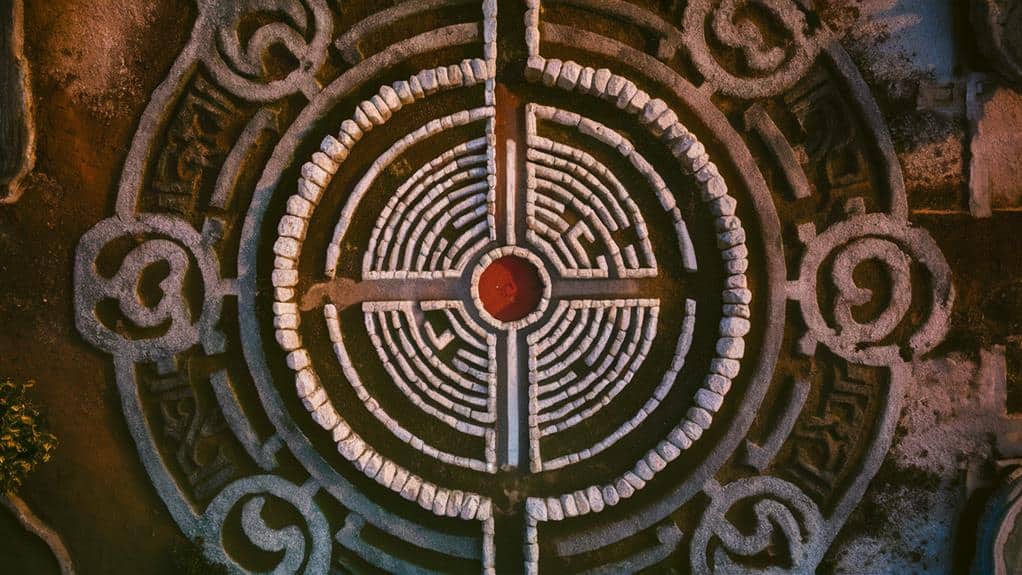
The origins of labyrinths and mandalas trace back thousands of years across multiple civilizations. You’ll find these sacred patterns woven into the spiritual fabric of ancient cultures, from the intricate maze at Knossos in Crete to the sand mandalas of Tibetan Buddhism.
As you explore these geometric wonders, you’re walking in the footsteps of countless seekers who’ve used these designs as tools for meditation, enlightenment, and spiritual transformation.
When you study ancient traditions, you’ll discover that labyrinths weren’t meant to confuse but to illuminate – their single, winding path leading inevitably to the center mirrors your own journey toward self-discovery.
Meanwhile, mandalas emerged from Hindu and Buddhist practices, where they’ve served as cosmic maps and meditation aids. You’ll notice their circular designs representing the universe’s endless cycles and the interconnectedness of all existence.
These symbols aren’t relics of a distant past – they’re living traditions that continue to resonate.
As you trace a labyrinth’s path or contemplate a mandala’s symmetry, you’re participating in practices that have guided spiritual seekers for millennia, connecting you to an unbroken chain of human consciousness and quest for meaning.
Sacred Geometry in Mystical Design
Sacred principles of geometry underpin both labyrinths and mandalas, revealing mathematical patterns that ancient mystics believed connected earthly forms to divine order.
You’ll find the golden ratio, sacred spirals, and perfect circles woven into these designs, creating spaces where cosmic principles manifest in tangible form. Within these geometric frameworks, you’re invited to discover how universal mathematical constants echo throughout creation.
When you examine a mandala’s radiating symmetry, you’ll notice how it expands outward from a central point, mirroring the way consciousness unfolds from unity into multiplicity.
The labyrinth’s path, meanwhile, follows precise geometric proportions that guide you through calculated turns and straightaways, each step aligned with sacred measurements. You’re walking a pattern that embodies the divine order of creation itself.
These mystical designs aren’t merely decorative – they’re encoded with profound mathematical relationships.
As you trace their forms, you’re engaging with the same geometric principles that govern galactic spirals and atomic structures. Through these sacred patterns, you’re connecting to an ancient understanding that saw mathematics as the bridge between physical reality and spiritual truth.
Walking the Labyrinth Path
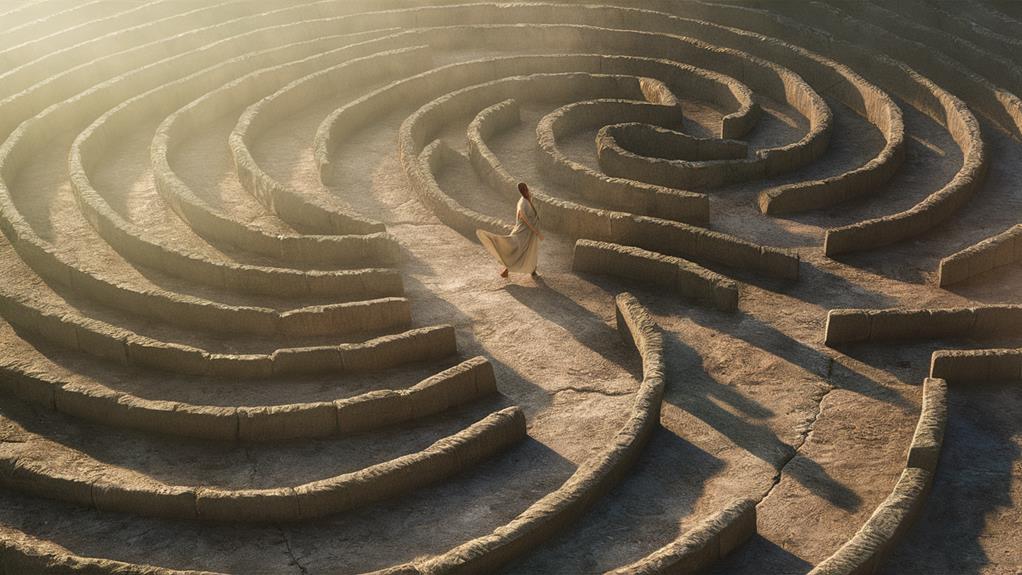
Pilgrims throughout history have walked labyrinth paths as a form of moving meditation, following a single winding route that leads inevitably to the center. As you trace these ancient patterns, you’ll find that each step becomes a metaphor for life’s journey, where the path, though complex, always guides you toward profound self-discovery.
You’ll notice that walking a labyrinth isn’t like maneuvering through a maze – there aren’t any wrong turns or dead ends to confound you. Instead, you’re invited to surrender to the journey itself, allowing your thoughts to settle as your feet carry you through the turns.
The path’s gentle curves will draw you inward, both physically and spiritually, as you wind your way toward the center point of stillness.
When you reach the heart of the labyrinth, you’re standing in a space that represents your own inner sanctuary. Here, you can pause, reflect, and receive whatever insights emerge.
The return journey transforms you further, as you carry your center-point experience back into the world, integrating your discoveries with each mindful step outward.
Creating and Dissolving Sand Mandalas
Moving from walking meditations to artistic contemplation, Buddhist monks showcase another profound form of spiritual practice through sand mandalas.
You’ll witness their patient hands carefully placing millions of colored sand grains, creating intricate geometric patterns that symbolize the universe’s cosmic order and the path to enlightenment. Each delicate line and sacred symbol emerges through hours of focused concentration, as you observe their unwavering dedication to this ancient art form.
When you’re present for the mandala’s creation, you’ll notice how the monks work in perfect harmony, their movements precise and intentional.
Yet what’s most striking isn’t the stunning artistry—it’s the mandala’s inevitable dissolution. You’ll watch as they sweep away their painstaking work, releasing the colored sands into flowing water, demonstrating the impermanence of all things.
This powerful ritual teaches you to release attachment, reminding you that everything in life, no matter how beautiful or meaningful, eventually transforms.
In this practice, you’ll discover that the process of creation and dissolution holds as much significance as the mandala itself, offering profound lessons about the cyclical nature of existence.
Meditation Techniques Using Sacred Patterns
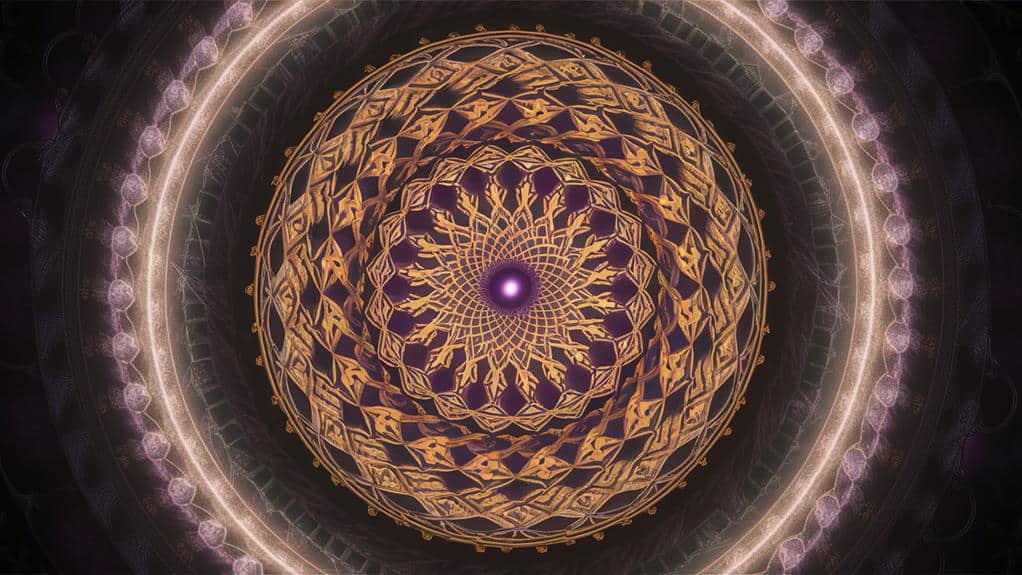
Drawing from ancient wisdom traditions, practitioners have developed diverse meditation techniques centered around sacred geometric patterns. You’ll discover that these practices invite you to align with universal forces through mindful engagement with mandalas and labyrinths, opening doorways to heightened consciousness and inner transformation.
When you sit before a mandala, you’ll want to begin by softening your gaze, allowing the intricate patterns to draw your attention naturally toward the center. Let your awareness flow through the symmetrical forms, noticing how they guide you inward while simultaneously expanding your perspective outward.
You’re not just observing the pattern; you’re entering into dialogue with an ancient symbolic language that speaks directly to your unconscious mind.
With labyrinth meditation, you’ll find yourself engaging in a walking practice that mirrors your inner journey. As you trace the path with your finger or walk its curves, you’re invited to release your analytical mind and surrender to the pattern’s flow.
Each turn becomes a metaphor for life’s changes, while the center represents your core truth, waiting to be discovered through patient, contemplative engagement.
Psychological Benefits of Pattern Work
The psychological benefits of working with sacred patterns extend far beyond simple relaxation. When you engage with labyrinths and mandalas, you’re activating deep neural pathways that help integrate your conscious and unconscious mind, creating a bridge between your analytical thinking and intuitive wisdom.
You’ll find that regular practice can reduce anxiety, enhance focus, and foster a profound sense of inner coherence. As you trace these ancient patterns, whether with your feet or your eyes, you’re engaging in a form of active meditation that’s been shown to lower cortisol levels and increase alpha brain wave activity.
The circular nature of mandalas and the winding paths of labyrinths mirror your own inner journey, helping you process complex emotions and untangle mental knots. You’ll discover that these sacred geometries serve as powerful tools for psychological integration, allowing you to access deeper layers of self-understanding.
Through this contemplative practice, you’re not just following lines and curves – you’re mapping your own consciousness, creating new neural connections that support emotional resilience and psychological wholeness.
Each session strengthens your capacity for self-reflection and enhances your ability to navigate life’s complexities with greater clarity.
Cultural Significance Across Societies
Sacred patterns like labyrinths and mandalas have emerged independently across countless civilizations, revealing their universal appeal to the human psyche.
You’ll find these intricate designs adorning ancient temple walls from Tibet to Peru, woven into indigenous textiles, and traced in the ceremonial grounds of diverse spiritual traditions. Each culture has imbued these patterns with its own sacred meanings, yet they all share a common thread of representing life’s journey and cosmic order.
When you explore European cathedrals, you’ll discover medieval labyrinths that served as symbolic pilgrimages, allowing devotees to trace holy paths when they couldn’t journey to sacred sites.
In Buddhist and Hindu traditions, you’ll encounter mandalas representing the universe’s structure, used as powerful tools for meditation and spiritual awakening.
Native American medicine wheels echo these circular patterns, creating sacred spaces for healing and communion with spiritual forces.
Even today, you’ll see these ancient designs finding new life in contemporary spiritual practices, where they continue to serve as bridges between the physical and spiritual domains, transcending cultural boundaries while maintaining their power to transform consciousness.
Modern Applications in Spiritual Practice
Modern seekers have rediscovered labyrinths and mandalas as powerful tools for mindfulness, stress reduction, and personal transformation. You’ll find these sacred geometries integrated into contemporary meditation centers, wellness retreats, and spiritual communities, where they serve as gateways to deeper states of consciousness and self-discovery.
When you engage with a labyrinth’s winding path, you’re participating in a walking meditation that mirrors life’s journey – each step bringing you closer to your center while teaching presence and patience.
Mandalas, whether you’re creating or contemplating them, offer a focal point for meditation that can help you access altered states of awareness and reveal creative potential.
You’ll discover these ancient tools adapted for modern healing practices, from art therapy sessions to spiritual counseling. Digital applications now offer virtual labyrinth walks and mandala-creation experiences, while hospitals and hospices incorporate these symbols into their healing environments.
Through these contemporary adaptations, you’re connecting to a timeless wisdom that transcends cultural boundaries, allowing you to explore your inner landscape while remaining grounded in present-day spiritual practice.
Symbolism and Sacred Meaning
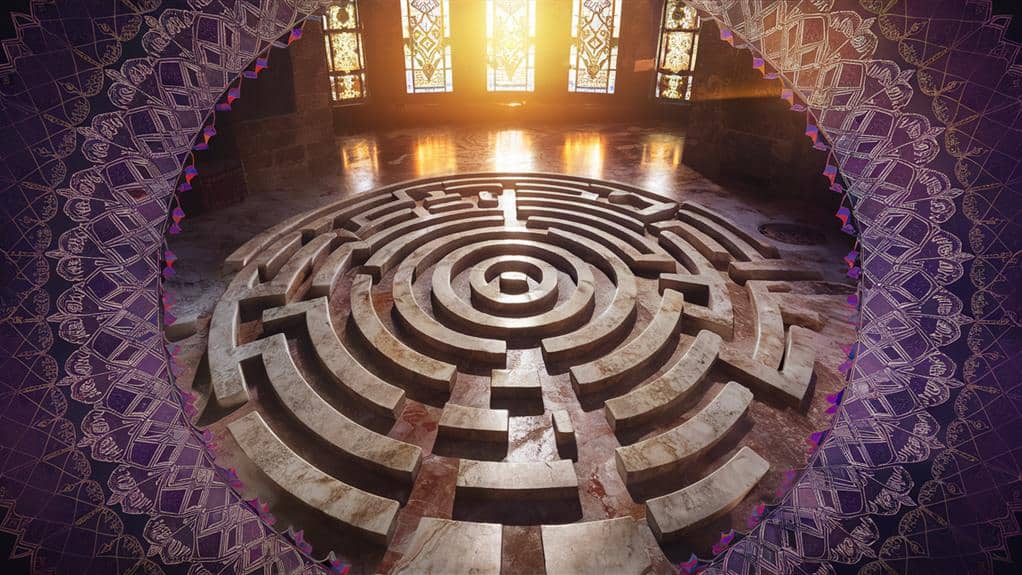
Profound symbolism permeates both labyrinths and mandalas, carrying layers of meaning that span cultures and spiritual traditions. You’ll find that these sacred patterns reflect the universe’s inherent order, with mandalas representing cosmic wholeness and labyrinths embodying life’s transformative journey.
In both forms, you’re encountering ancient wisdom that speaks to your soul’s deepest yearnings. As you explore these symbols, you’ll discover how the mandala’s circular form points to completion and unity, while its intricate patterns mirror the complexity of existence itself.
The labyrinth’s winding path invites you to embrace uncertainty, teaching that the journey inward is as essential as reaching the center. You’re walking a path that countless seekers have traversed, each curve and turn holding significance beyond mere geometry.
Within these sacred designs, you’ll recognize universal truths: the spiral of creation, the dance of opposing forces, and the eternal cycle of death and rebirth. Whether you’re meditating on a mandala’s symmetry or following a labyrinth’s meandering course, you’re engaging with symbols that transcend time, culture, and individual understanding.
Integrating Patterns Into Daily Life
Bringing the wisdom of labyrinths and mandalas into your everyday routine doesn’t require elaborate ceremonies or special spaces. You’ll find these sacred patterns echoing throughout nature and your daily environment – in the spiral of morning frost on your window, the concentric ripples in your coffee cup, or the winding path you take through city streets on your commute.
Begin by noticing these natural mandalas and labyrinths in your surroundings, allowing their presence to remind you of life’s deeper rhythms. You might trace a finger labyrinth while waiting for your morning train or draw simple mandala patterns during your lunch break.
Consider transforming routine activities into walking meditations – whether you’re moving through grocery store aisles or traversing your neighborhood park.
You can create mindful moments by incorporating these patterns into your living space: arrange stones in a spiral on your desk, design a small herb garden in concentric circles, or place a printed labyrinth pattern beneath clear glass on your coffee table.
Let these conscious arrangements serve as anchors, drawing you back to center when life’s complexities threaten to overwhelm your sense of direction.



